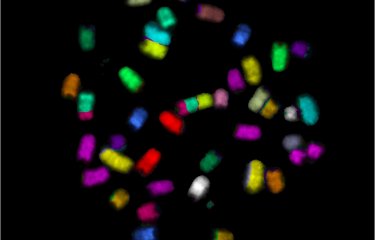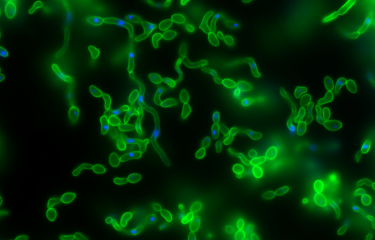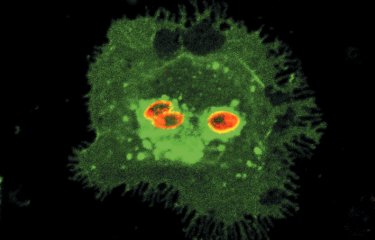Homologous recombination is one of the major pathways for repairing broken DNA. A study by scientists from the Institut Pasteur and ENS Lyon shows how a protein known as cohesin reorganizes the genome into loops to enable this process.
Within (nearly) all of our cells, 23 pairs of chromosomes, encapsulated in the cell nucleus, encode the workings of the body. The stability of this genetic material is vital for all cell processes and, by extension, for keeping our body in good health. But accidents can occur, caused for example by radiation or errors in chromosome copying, and this can result in one or more breaks in both DNA strands. If these breaks are poorly repaired, they can lead to harmful and pathogenic rearrangements, which may cause cancer. Scientists in the Spatial Regulation of Genomes Unit at the Institut Pasteur are working in collaboration with the Genome Mechanics team at ENS Lyon on homologous recombination, one of the methods the body uses to restore genetic code in the event of an accident.
Homologous recombination is a highly conserved repair pathway in the living world which uses genome sequences similar to the damaged sequence, often taken from the homologous chromosome of the pair, which in principle is identical. If this sequence is unavailable, the two ends of the break search for genome regions that resemble them so that proteins can then reconstruct the missing section from the intact chromosome and reconnect the strands. In a recent publication in Nature Cell Biology, the scientists studied the 3D configuration of chromosomes when a break occurs. "How does the presence of a break affect chromosome folding? And how does this folding affect the way in which the break is repaired? These were the questions we wanted to answer," explains Hélène Bordelet from the Spatial Regulation of Genomes Unit, one of the co-lead authors of the study.
DNA loops constrain the search for homologous regions
The scientist and her colleagues worked on the yeast Saccharomyces cerevisiae, which also uses the process of homologous recombination. They introduced breaks in the yeast genome and used a chromosome conformation capture technique to model the spatial organization of the chromosome. They induced a chromosomal break while the cells were arrested in metaphase (one of the stages of cell division). They observed that the chromosomes reorganize themselves in such a way as to form arrays of chromatin loops that are characteristic of this stage of the cell cycle, as previously shown by the team (see Importance of cohesin to yeasts' 3D chromosome structure). These loops are assembled with the help of a ring-shaped protein, cohesin, which positions itself at the base of each of the loops and holds them together.
Once the chromosome has been organized in this way, the repair can be carried out. The scientists demonstrated that within this highly structured context, the DNA break is positioned at the base of the two loops, where the cohesin accumulates. "The search for a homologous region is therefore constrained by the formation of loops that are regulated by cohesin," explains Romain Koszul, Head of the Spatial Regulation of Genomes Unit. The repair process is guided by these structural constraints to sequences located within the same chromosome. This limits the risk of translocations between chromosomes, in other words the exchange of portions of DNA between different chromosomes, which can be pathogenic.
This study sheds light on one of the main mechanisms involved in genome stability. It also reveals causal links between the spatial organization of DNA and its repair processes. The publication also suggests that cohesin could be involved in other search processes for homologous regions. It opens up new avenues that could improve our understanding of the functions of genetic material and defects in these functions.
This study is part of the Cancer Initiative of the Institut Pasteur's strategic plan for 2019-2023.
Source :
Cohesin regulates homology search during recombinational DNA repair, Nature Cell Biology, November 16, 2021
Aurèle Piazza1,2, Hélène Bordelet1,2, Agnès Dumont2, Agnès Thierry1, Jérôme Savocco2, Fabien Girard1 and Romain Koszul1
1 - Unité Régulation Spatiale des Génomes, Institut Pasteur, Paris, France.
2 - Université de Lyon, ENS de Lyon, Université Claude Bernard, Laboratoire de Biologie et Modélisation de la Cellule, Lyon, France.





